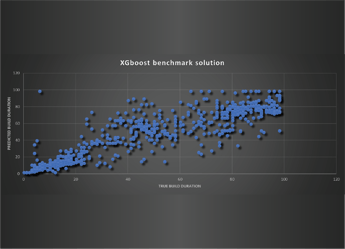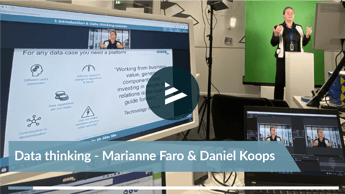Robot-controlled platform keeps configurations under control
In today’s digital transformation, we have a complex puzzle to put together. Which components of the application landscape can you take (or do you want to take) from SaaS? Which applications are suited to IaaS or PaaS, and do you choose for your own private cloud or the public cloud? How do you link all this together and how do you keep your legacy environment up and running 24/7? How do you ensure a predictable level of service? And last but not least: is it really possible to respond flexibly to the new developments required by business customers?
In my opinion, you can only answer these questions by focusing on automation and analytics. And by applying software and data science in your own IT domain, to keep all the pieces of the puzzle in order. You will only achieve smart sourcing by regarding all components as ‘sourced’ and opting for far-reaching automation.
Starting point
Big enterprises are continually struggling to keep their IT under control. They cannot get a grip on the large numbers of users who change the even larger numbers of configurations in operations or during projects. Sometimes this happens deliberately and sometimes not, within their own organization or outside it. Besides the need for control, there is the pressure of wanting to introduce innovative changes to the IT landscape at an ever increasing pace. More and more often, we pass the hot potato on to external parties (outsourcing) or buy the umpteenth sexy tool that promises to solve the problem.
We do not really know what is going on in our IT environments and how they are configured. The production line runs in fits and starts. We spend a considerable amount of time, correcting, and adjusting the technical settings of the IT environment: the configuration. Recording the multitude of settings in the traditional way has proved a never-ending task.
The effect of changes is often unpredictable, which results in low quality. In our IT factories, many people are predominantly occupied with repairing the machine instead of with innovation. And if there is a lot of outsourcing, our people are burdened with an extra workload, as they are then also responsible for management and steering.
Mindset
Based on the functional needs of the end user, we focus on the software and hardware semifinished products. Semi-finished products are supplied by cloud providers (private and public), regular IT service providers or internal departments. We assemble the semifinished products through configuration. Once in production, however, we let go of the configurations too much. This soon leads to quality issues due to ‘broken’ products as a consequence of changes within the environment and outside it.
Why do we let this happen? Why do we think that products do not break down in our IT world? Wouldn’t it be great if we could keep a tight grip on the whole thing and manage our suppliers? Released from all that repair work, IT professionals could then work faster on innovating for our business. What sort of platform do we need for this?
Robot-controlled
We need a platform that keeps control of the configurations over all the IT components and suppliers, keeping the defined end service in mind. A platform that provides people with the means to change, stimulate and improve the IT production line - without directly working ‘low down’ the configuration line themselves.
In other words, a platform that provides uniformity and automation in the configuration management of all IT components. A platform that is continually interpreting what happens in the IT landscape, supported by machine learning. A platform that gives an uncluttered and situational view of the landscape. A platform that is continually learning and predicting how the IT landscape is behaving and how it can be improved in the broad sense of the word. Indeed, we are talking about an IT robot. Such a platform is supported by software and analytics, but also largely by the people operating the platform.
People who are continually developing the landscape on the basis of a vision of improving things, rather than people who work from the perspective of repair work. The platform is integrated with the target: the IT environment. But the platform has to operate more broadly; for example, in the context of IoT or any other network or technology system, with or without hardware, and within its own business walls or outside them. The foundation is ‘as-code, always’.
We manage the IT systems with code and recipes, just as a factory line is operated by a physical robot – along with the operator (i.e. software guy), who in turn operates the robots. This set-up is different to the one we are used to in regular IT operations. The robot takes over the traditional maintenance work within the platform, which results in a radical simplification of IT operations, freeing up time for continuous innovation.
Smart sourcing
Such a platform supports the smart-sourcing policy of the user. It is based on several principles, with a focus on continuous and iterative innovation. We manage everything through the robot. The target system is never ‘finished’ and there are continual changes – also in sourcing.
So it is necessary to have a strong modular set-up: software or cloud components have to be easy to replace if they no longer provide sufficient flexibility or become too expensive. These can include traditional components like closed-source software, as well as open-source components or cloud services. Here, too, software lends a helping hand – functioning as theIT robot heralds the end of our traditional, ITIL-based IT.
Implementation
An implementation of the platform must consist of various software components: an ‘infra as code’ translation layer, an API layer and the analytics correlator as the brain of the system. It is people who manage the platform and make it smarter: the analytics expert and the operator play the main roles.
This operator is the new system admin: he or she has a strong software background and takes on a DevOps role. This is all necessary in order to be able to manage the configurations of the target IT environments with robots. This is how you achieve digital transformation in IT operations. Smart sourcing based on design is the first step on the road to the end of our traditional, ITIL-based IT operations.
Click here to read and learn all about Itility Cloud Control — a different approach to IT operations.






